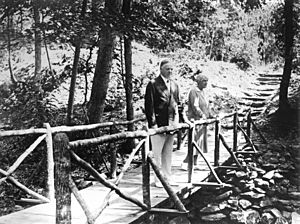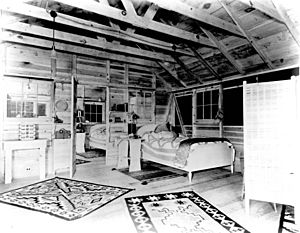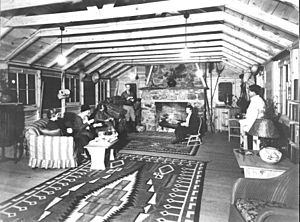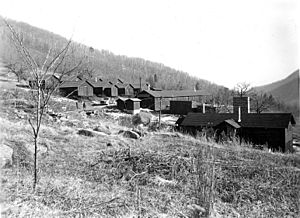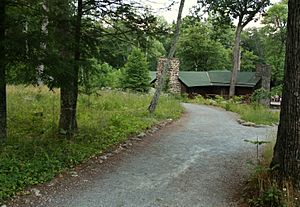Rapidan Camp facts for kids
|
Camp Hoover
|
|

The Rapidan Camp "Brown House" in Hoover's Time
|
|
| Nearest city | Syria, Virginia |
|---|---|
| Built | 1929 |
| Architect | Lou Henry Hoover, US Marine Corps |
| NRHP reference No. | 88001825 |
Quick facts for kids Significant dates |
|
| Added to NRHP | June 7, 1988 |
| Designated NHLD | June 7, 1988 |
Rapidan Camp (also known as Camp Hoover) is a special place located in Shenandoah National Park in Madison County, Virginia. It was built by U.S. President Herbert Hoover and his wife Lou Henry Hoover. This rustic retreat was their getaway from 1929 to 1933, during Hoover's time as president. The main cabin where the First Family lived was called the "Brown House." This was a fun contrast to their more famous home, the White House.
Rapidan Camp was like an early version of today's presidential retreat, Camp David.
Contents
Building a Presidential Retreat
Why President Hoover Needed a Getaway
In November 1928, Herbert Hoover was elected as the 31st president of the United States. Unlike earlier presidents who lived closer to Washington, D.C., Hoover was from Iowa and had spent a lot of time in California. It was hard for him to go home often to escape the busy life of the presidency. So, he wanted a quiet place closer to Washington.
Hoover and his wife, Lou Henry Hoover, loved being in isolated places. They had lived in mining camps for over 10 years when he was a mine engineer. President Hoover asked his secretary, Lawrence Richey, to find a secret spot. It needed to be within 100 miles (160 km) of Washington, D.C. It also had to be high up, at least 2,500 feet (760 m) above sea level, to avoid mosquitoes. Most importantly, it needed to be near an excellent trout stream for fishing.
Choosing the Perfect Spot
Virginia Governor Harry F. Byrd was working to create Shenandoah National Park. He suggested that President-elect Hoover and his wife look at the headwaters of the Rapidan River. This remote area was on Doubletop Mountain, in the Blue Ridge Mountains of Madison County. Two streams, Mill Prong and Laurel Prong, meet there to form the Rapidan River. All three streams were great for fishing.
Less than three weeks after Hoover became president in March 1929, the news spread that they had chosen the Rapidan site. Virginians offered to give the camp to Hoover. However, the President used his own money to buy the land for $1,045. He also paid $22,719 for building materials. The Marine Corps helped build the camp as a "military exercise."
Building the Camp with the Marines
The Hoovers first thought about having a village of tents. But they soon decided on a more permanent settlement. Mrs. Hoover was in charge of the building project. The Marines built thirteen different buildings. These included a lodge, two dining halls, cabins, and a "Town Hall." They also made several miles of hiking trails, a stone fountain, and even a miniature golf course.
With one exception, this was the most difficult task in my career as an engineer, covering about 25 years. ... It would have been easier to have moved an army of 10,000 men across the Blue Ridge than to have built this camp. I have been amazed to find so wild an area existing here so close to eastern cities.
To save money, President Hoover stopped using the Presidential Yacht Mayflower. The Filipino crew from the yacht, along with kitchen supplies, were moved to Rapidan Camp.
Life at the Presidential Retreat (1929–1933)
Enjoying Nature and Privacy
Rapidan Camp covered 164 acres (66 hectares). President Hoover loved fishing in the streams, which were stocked with trout. Mrs. Hoover enjoyed riding horses at the camp. The state of Virginia even added a one-mile road extension to make it easier to reach the camp. This road is still unpaved today. The New York Times called the camp "frontier-like." Mrs. Hoover described the drive and the camp:
This camp,—at the end of nowhere, with a road that in wet weather lets you sink to your hubs in slushy mush and while there bump over the most amazing boulders ... —has electric lights and a telephone and its morning papers. The mail is dropped from an airplane!
On August 17, 1929, President Hoover gave a speech about fishing and his camp. He said fishing was a great way for presidents to escape and think. He also said that "all men are equal before fishes." This meant that nature treats everyone the same, no matter how important they are.
Fishing was usually done outside the camp grounds. The fish inside the camp were so used to people that they would swim up if you threw a pebble in the water.
Important Guests and Meetings
Leaders from the U.S. and other countries came to Rapidan Camp for important meetings with the President. Famous guests included inventor Thomas A. Edison, aviator Charles Lindbergh and his wife Anne Morrow Lindbergh, and British Prime Minister Ramsay MacDonald. President Hoover and his guests often went fishing right after they arrived.
The press was rarely invited to Rapidan Camp. However, President Hoover did have friends in the press, like cartoonist "Ding" Darling. Darling shared Hoover's interest in conservation. On one visit, Ding and the President rode horses and briefly escaped the Secret Service. They dammed a creek, cooked lunch, and watched the Secret Service search for them.
Hoover sometimes stopped for picnics by the road. Other times, he left camp so quickly that sandwiches were sent to him on the way. The camp had a large outdoor stone fireplace. This fireplace was the background for many photos of the Hoovers and their guests.
At Rapidan Camp, President Hoover and Prime Minister MacDonald discussed important world issues. They reached an agreement that led to the 1930 London Naval Treaty. This treaty was about limiting naval weapons. Rapidan Camp also gave its name to the "Rapidan Plan." This plan involved the Girl Scouts of the USA helping during the big economic problems of the time.
The Birthday Opossum and the Mountain School
A well-known story happened in August 1929. A boy from the nearby mountains gave President Hoover a live opossum for his 55th birthday. Six months later, the President helped build a new schoolhouse in that remote area. Before this, there was no school there.
The story began weeks earlier when Admiral Joel T. Boone, Hoover's doctor, met an eleven-year-old boy named Ray Buracker. Boone learned that Ray and his eight brothers and sisters had never been to school. Their area, called Dark Hollow, had no school. When the President heard about Ray, he said, "Tell that boy if he will bring me an opossum down here I'll give him five dollars." Ray brought the opossum on August 10, the President's birthday. He presented it directly to the President and his guest, Charles Lindbergh.
President Hoover raised money to build a small schoolhouse. It even had an apartment for the teacher, Christine Vest. The first class had twenty-two students, aged 6 to 20. The story of this mountain schoolhouse became famous across the country. People sent donations like schoolbooks, furniture, and a piano. The President took a personal interest in the school. He welcomed its students to the White House many times.
After Hoover left office, fewer students attended the school. This was because people in the area had to move for the creation of Shenandoah National Park in 1935. The school building was moved to Big Meadows on Skyline Drive. It was then used as a ranger station and a home.
Cabinet Members' Camp
In 1930, some of Hoover's cabinet members had the Marines build a separate camp for them. It was about 2 miles (3.2 km) downriver from the President's camp. This "Cabinet Camp" was on land that was supposed to become part of Shenandoah National Park.
In 1953, a group of 14 families bought the old Cabinet Camp. They fixed up the cabins. Over the years, this group grew to about 100 families. They share the facility as a seasonal retreat. The camp now has five cabins. Three are original Hoover-era cabins, and two were built later in a similar style. It is now called "Rapidan Family Camp" on hiking maps. This helps tell it apart from the President's main camp, which was renamed "Rapidan Camp" in 2004.
Marine Camp
A separate camp was built about 1 mile (1.6 km) east of Camp Rapidan. This was for the Marines who built, maintained, and guarded the camp. At first, it had mostly tents and a few wooden cabins. Later, more cabins replaced the tents. Many Marines were chosen for this duty because they were skilled in carpentry, plumbing, and other work needed at the camp. When the President was at camp, 150 to 250 Marines were there. In the winter, only about a dozen stayed.
The Marine Camp was taken down in 1944.
Rapidan Camp After Hoover (1933–Present)
Federal and Boy Scout Camp (1933–2000)
When President Hoover lost his election in 1932, he and his wife offered the camp to future presidents. They also gave the camp property to the federal government. It became part of the new Shenandoah National Park.
President Franklin D. Roosevelt visited Rapidan Camp in 1933. However, the narrow trails were too rough for his wheelchair. The mountain streams were also too cold for swimming. Roosevelt later created his own retreat in Maryland, which became Camp David. Rapidan Camp then fell into disrepair.
In 1948, the Boy Scouts of America were allowed to use the camp as a summer camp for twenty years. This was also what Hoover had wanted. When the Boy Scouts used it, the facility was renamed "Camp Hoover." But maintenance costs became too high, and the Scouts left in 1958. In 1960, many of the Boy Scout buildings and old Hoover-era buildings were torn down. Only three of the original buildings remained.
From 1960 to 1992, the camp was a vacation spot for high-ranking federal government officials. This included Vice President Walter Mondale and Vice President Al Gore.
The camp was named a National Historic Landmark in 1988, under the name "Camp Hoover."
Restored and Open to the Public (2001–Present)
In 2004, Shenandoah National Park finished restoring the grounds and the three remaining cabins. They were brought back to how they looked during Hoover's presidency. The three buildings are the Brown House (President's Cabin), the Prime Minister's Cabin, and the Creel. Signs have been put up to help visitors understand what life was like in 1931. The camp's name was officially changed back to Rapidan Camp.
The river is still famous for its trout fishing.
How to Visit Rapidan Camp Today
Rapidan Camp can be reached by a 4.1 mile (6 km) round-trip hike on the Mill Prong Trail. This trail starts on Skyline Drive at Milam Gap. The National Park Service also offers guided van trips from the Harry F. Byrd Visitor Center at Big Meadows. During much of the spring, summer, and fall, a guide stays at the camp and gives tours. The Brown House is decorated as it was in Hoover's time. The Prime Minister's Cabin has exhibits for visitors.
Camp Architecture
Lou Henry Hoover hired an architect who had designed Girl Scout camps to create the cabins at Rapidan Camp. The buildings were simple. Some early structures, like the "Five Tents," had only a wooden floor and 3-foot-high (0.91 m) walls, with canvas tents on top. Even the President's Cabin had thin walls with no insulation. There were no ceilings inside, so you could see the rafters and roof boards. Shower stalls had tin walls and concrete floors. In Hoover's time, cabin porches had flower boxes with geraniums, and floors had grass rugs. The camp was changed and added to throughout Hoover's presidency.
On cold days, large stone fireplaces provided some warmth. There was plenty of firewood because a disease had damaged many chestnut trees. Mrs. Hoover once wrote that there were "innumerable, enormous dead chestnuts standing all over the place."
On hot days, wooden panels could be folded down to show large copper screens. These screens and many windows helped with air flow. In the 1960s to 1980s, thick hemlock trees kept the camp cool. However, in the early 1990s, tiny insects called hemlock woolly adelgid started destroying the hemlock trees. So, the forest around the camp now has many dead trees, just like in Hoover's day.
The cabins have electricity and plumbing, with wires visible along the walls. Large outdoor decks were built with holes for tree trunks. The branches of these trees shaded the cabins and porches.
A copy of a part of the President's cabin and its deck is located inside the Hoover Presidential Library in Iowa.
See also




